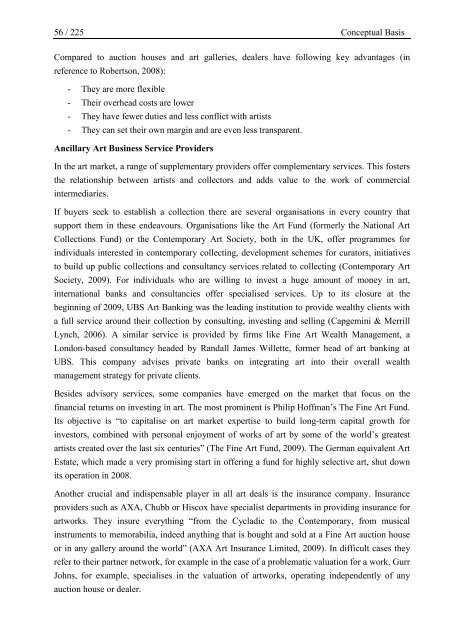Management of Art Galleries – Business Models - Universität St.Gallen
Management of Art Galleries – Business Models - Universität St.Gallen
Management of Art Galleries – Business Models - Universität St.Gallen
Create successful ePaper yourself
Turn your PDF publications into a flip-book with our unique Google optimized e-Paper software.
56 / 225 Conceptual BasisCompared to auction houses and art galleries, dealers have following key advantages (inreference to Robertson, 2008):- They are more flexible- Their overhead costs are lower- They have fewer duties and less conflict with artists- They can set their own margin and are even less transparent.Ancillary <strong>Art</strong> <strong>Business</strong> Service ProvidersIn the art market, a range <strong>of</strong> supplementary providers <strong>of</strong>fer complementary services. This fostersthe relationship between artists and collectors and adds value to the work <strong>of</strong> commercialintermediaries.If buyers seek to establish a collection there are several organisations in every country thatsupport them in these endeavours. Organisations like the <strong>Art</strong> Fund (formerly the National <strong>Art</strong>Collections Fund) or the Contemporary <strong>Art</strong> Society, both in the UK, <strong>of</strong>fer programmes forindividuals interested in contemporary collecting, development schemes for curators, initiativesto build up public collections and consultancy services related to collecting (Contemporary <strong>Art</strong>Society, 2009). For individuals who are willing to invest a huge amount <strong>of</strong> money in art,international banks and consultancies <strong>of</strong>fer specialised services. Up to its closure at thebeginning <strong>of</strong> 2009, UBS <strong>Art</strong> Banking was the leading institution to provide wealthy clients witha full service around their collection by consulting, investing and selling (Capgemini & MerrillLynch, 2006). A similar service is provided by firms like Fine <strong>Art</strong> Wealth <strong>Management</strong>, aLondon-based consultancy headed by Randall James Willette, former head <strong>of</strong> art banking atUBS. This company advises private banks on integrating art into their overall wealthmanagement strategy for private clients.Besides advisory services, some companies have emerged on the market that focus on thefinancial returns on investing in art. The most prominent is Philip H<strong>of</strong>fman’s The Fine <strong>Art</strong> Fund.Its objective is “to capitalise on art market expertise to build long-term capital growth forinvestors, combined with personal enjoyment <strong>of</strong> works <strong>of</strong> art by some <strong>of</strong> the world’s greatestartists created over the last six centuries” (The Fine <strong>Art</strong> Fund, 2009). The German equivalent <strong>Art</strong>Estate, which made a very promising start in <strong>of</strong>fering a fund for highly selective art, shut downits operation in 2008.Another crucial and indispensable player in all art deals is the insurance company. Insuranceproviders such as AXA, Chubb or Hiscox have specialist departments in providing insurance forartworks. They insure everything “from the Cycladic to the Contemporary, from musicalinstruments to memorabilia, indeed anything that is bought and sold at a Fine <strong>Art</strong> auction houseor in any gallery around the world” (AXA <strong>Art</strong> Insurance Limited, 2009). In difficult cases theyrefer to their partner network, for example in the case <strong>of</strong> a problematic valuation for a work. GurrJohns, for example, specialises in the valuation <strong>of</strong> artworks, operating independently <strong>of</strong> anyauction house or dealer.
















